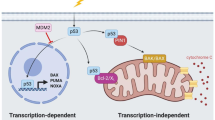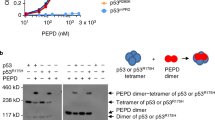Abstract
A tumour suppressor function for p53 is indicated in human lung cancer and in carcinoma of the colorectum. Loss of suppressor function, by mutation of the p53 gene, is associated with activation of p53 as an oncogene. The suppressor (wild type) and oncogenic (mutant) forms of the murine p53 protein are distinguishable at the molecular level by reactivity with anti-p53 monoclonal antibodies. For example, activated mutant p53 fails to react with PAb246 (p53-246 degrees). We now demonstrate that wild type p53 mRNA can be expressed either as p53-246+ or p53-246 degrees. We propose that p53-246 degrees may represent an allosteric variant of wild type p53 compatible with positive growth control. Thus, for wild type p53 the variants p53-246+ and p53-246 degrees may reflect suppressor and activator functions of p53 in the normal control of cell proliferation. For human p53 we present evidence that the epitope recognised by PAb1620 is analogous to that for PAb246 on murine p53. Thus the epitope for PAb1620 may prove to be of use as a marker for wild type human p53 with anti-oncogenic function.
This is a preview of subscription content, access via your institution
Access options
Subscribe to this journal
Receive 24 print issues and online access
$259.00 per year
only $10.79 per issue
Buy this article
- Purchase on Springer Link
- Instant access to full article PDF
Prices may be subject to local taxes which are calculated during checkout
Similar content being viewed by others
Author information
Authors and Affiliations
Rights and permissions
About this article
Cite this article
Cook, A., Milner, J. Evidence for allosteric variants of wild-type p53, a tumour suppressor protein. Br J Cancer 61, 548–552 (1990). https://doi.org/10.1038/bjc.1990.123
Issue Date:
DOI: https://doi.org/10.1038/bjc.1990.123
This article is cited by
-
Structure–function–rescue: the diverse nature of common p53 cancer mutants
Oncogene (2007)
-
Reactivation of mutant p53: molecular mechanisms and therapeutic potential
Oncogene (2007)
-
The ‘wildtype’ conformation of p53: epitope mapping using hybrid proteins
Oncogene (2001)
-
A novel exon within the mdm2 gene modulates translation initiation in vitro and disrupts the p53-binding domain of mdm2 protein
Oncogene (1999)
-
Identification of tumour-associated and germ line p53 mutations in canine mammary cancer
British Journal of Cancer (1999)



